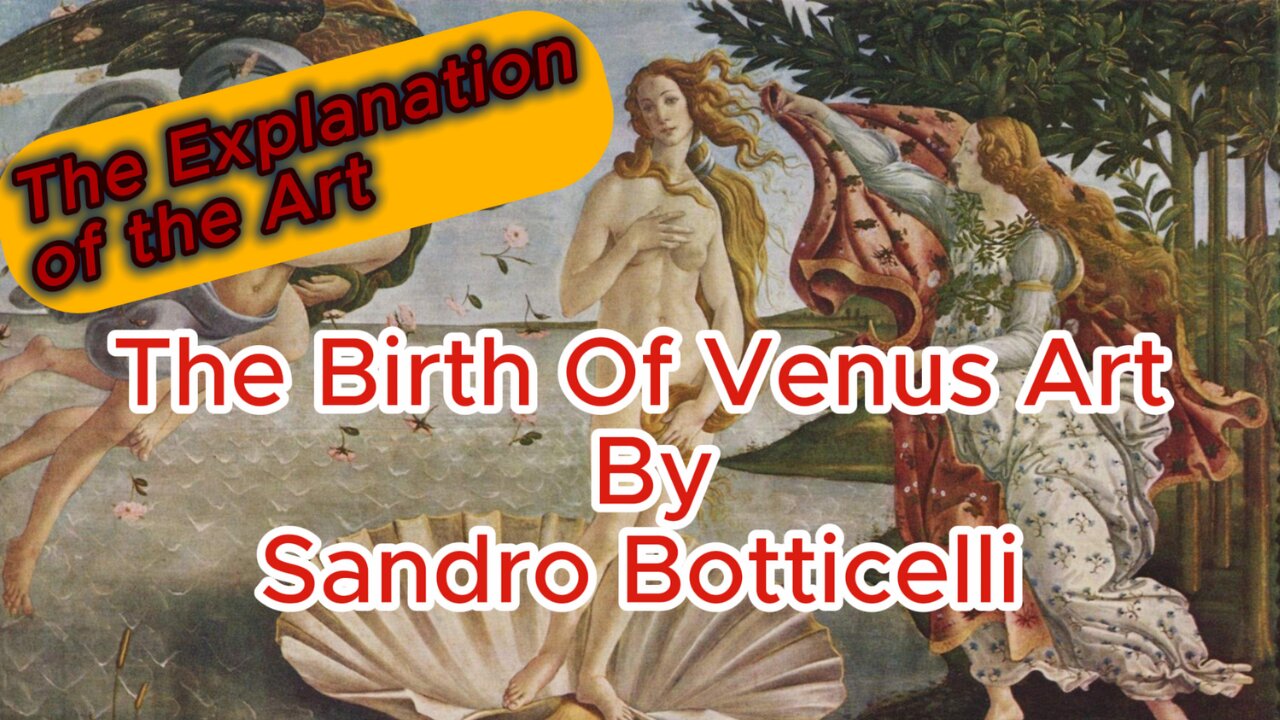Premium Only Content

"The Birth of Venus" Art by Sandro Botticelli | Explanation and Importance Of Art
#art #thebirthofvenus #Sandrobotticelli #RenaissanceArt
🔥 If you like the video, please like and share
🔔 Turn on notifications to stay updated with new uploads!
Overview:
"The Birth of Venus" is one of the most famous and celebrated paintings by Italian Renaissance artist Sandro Botticelli. Created around 1486, it depicts the goddess Venus emerging from the sea on a shell, fully grown, and arriving at the shore. The painting is housed in the Uffizi Gallery in Florence, Italy.
Subject Matter:
The central figure of the painting is Venus, the Roman goddess of love and beauty, who is depicted in an idealized, classical form. She stands on a large seashell, being blown towards the shore by Zephyrus, the god of the west wind, who is entwined with the nymph Chloris. On the shore, a Hora of spring (one of the goddesses of the seasons) waits to cloak Venus in a flower-covered robe.
Symbolism:
Venus: Symbolizes beauty, love, and fertility. Her pose is reminiscent of ancient statues of the goddess Venus Pudica (modest Venus), a classical reference that emphasizes purity and divine beauty.
Zephyrus and Chloris: Represent the force of nature and the breath of life. Their intertwined forms suggest the unity of natural elements in bringing Venus to the shore.
The Hora: Represents the spring season, symbolizing growth, renewal, and the lushness of nature.
Artistic Style:
Botticelli’s painting style in "The Birth of Venus" is characterized by its linear grace and delicate beauty. He employs tempera on canvas, which was a relatively novel choice compared to the more common wood panels of the time. The lines are fluid and rhythmic, contributing to the ethereal quality of the scene. Botticelli’s use of color is subtle yet vibrant, with a focus on soft pastels and gentle contrasts that enhance the otherworldly atmosphere.
Historical Context:
"The Birth of Venus" was created during the height of the Italian Renaissance, a period marked by a renewed interest in the art, philosophy, and literature of ancient Greece and Rome. This painting reflects the Renaissance humanist interest in classical mythology and the beauty of the human form. It is believed that the painting was commissioned by Lorenzo di Pierfrancesco de' Medici, a member of the powerful Medici family and a cousin of Lorenzo the Magnificent, a significant patron of the arts.
Interpretation:
The painting is often interpreted as an allegory of the birth of beauty and love in the world. Venus’s arrival from the sea foam is a metaphor for the emergence of divine beauty from the chaotic elements of nature. The painting's harmonious composition and serene beauty embody the Renaissance ideal of combining classical wisdom with contemporary aesthetics.
Cultural Impact:
"The Birth of Venus" has had a profound impact on art and culture. It has been the subject of extensive scholarly analysis and remains a quintessential example of Renaissance art. The image of Venus on the shell has been widely reproduced and referenced in various forms of media, symbolizing ideal beauty and the enduring legacy of classical mythology.
Conclusion:
Sandro Botticelli’s "The Birth of Venus" remains an iconic masterpiece that captures the essence of Renaissance art. Its combination of classical themes, graceful execution, and profound beauty continues to inspire and captivate audiences around the world. The painting stands as a testament to the enduring allure of mythological subjects and the timeless pursuit of artistic excellence.
#art #artwork #thebirthofvenus #artchannel #hystory #hystorical #SandroBotticelli #bestarts #bestartists #RenaissanceArt #ItalianRenaissance #FamousPaintings #ArtHistory #UffiziGallery #Venus #MythologyinArt #ClassicalArt #ArtAnalysis
-
 LIVE
LIVE
MrR4ger
13 hours agoSUNDAY FUNDAY w/ R4GER - VARIETY / DIABLO 4/ FOR HONOR / ETC?
97 watching -
 5:40
5:40
WhaddoYouMeme
3 days ago $0.13 earnedThey’re Calling This the End of Masculinity
5.95K5 -
 15:24
15:24
Tactical Advisor
16 hours agoBest 2011 of 2025 | Bul Armory Ultralight Pro
4.59K -
 27:31
27:31
True Crime | Unsolved Cases | Mysterious Stories
2 days ago $0.03 earnedThe Hong Kong Schoolgirl Mystery – 5 Mysterious Unsolved Cases (Part 8)
5.38K1 -
 7:19
7:19
China Uncensored
23 hours agoChina is DONE in the South China Sea
6.67K11 -
 LIVE
LIVE
Joe Donuts Live
3 hours ago🟢 Loot Rats Unleashed: Arena Breakout Chaos! | Joe + Tony + Vlad
350 watching -
 30:37
30:37
Degenerate Plays
15 hours agoThis College Is Out Of Control - GTA Online : Part 9
4.84K -
 16:28
16:28
Mrgunsngear
2 days ago $0.49 earnedBeretta 92XI SAO Sabbia Review - A Few Surprises
7.53K6 -
 1:48
1:48
Memology 101
1 day ago $0.02 earnedThis aged like milk for Tish James...
3.36K6 -

Boxin
3 hours agoGrounded! part 5
12.1K